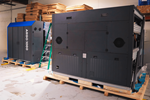CRG Defense secures $2 million contract to build hybrid military vehicle electric motors/generators
The effort also supports a broader initiative to accelerate hybrid-electric propulsion technologies to ground and air platforms, leveraging FRP structures and composite-based magnetic retention systems.
Source | U.S. Army, Sgt. Alison Strout
(previously Cornerstone Research Group, Miamisburg, Ohio, U.S.), has secured a $2 million U.S. Army contract to design and prototype a lightweight electric motor/generator system for hybrid-electric military vehicles. The effort supports a broader $17.25 million initiative to accelerate hybrid-electric propulsion technologies for next-generation ground and air platforms.
Under the contract, CRG Defense will develop a 50-kilowatt-class permanent magnet machine optimized for high-voltage (400-800 volt) military systems. The system will be designed, sourced and manufactured entirely in the U.S.
To achieve an aerospace-grade electric machine capability tailored to high torque, speed and packaging demands, the company told CW that it is leveraging advanced composite methods including:
- High-rate compression molded composites for efficient, scalable production
- Fiber-reinforced polymer (FRP) structures to reduce weight while maintaining durability
- Composite-based magnetic retention systems to secure permanent magnets in high-speed rotors, where the machine topology calls for it.
“This is a clean sheet design tailored to meet Army mission needs,” says Jake Monat, vice president of innovation at CRG Defense. “We’re building domestic capacity for power-dense electric machines that begin with defense applications and scale into commercial opportunities.”
According to CRG Defense, few U.S. suppliers currently offer high-voltage, high-power electric motors suitable for military use. Most are either foreign-made or designed for low-voltage systems. “This investment helps fill a critical industrial gap,” notes Chris Hemmelgarn, CTO. “We’re looking to partner with system integrators and OEMs that need custom-built, U.S.-made electric machines for air, land or maritime platforms.”
CRG Defense brings nearly three decades of experience developing integrated power and propulsion systems, including batteries, power electronics, controls and ducted fan technologies. This project builds on that foundation to deliver scalable, mission-ready solutions.
Related Content
-
Composites end markets: New space (2025)
Composite materials — with their unmatched strength-to-weight ratio, durability in extreme environments and design versatility — are at the heart of innovations in satellites, propulsion systems and lunar exploration vehicles, propelling the space economy toward a $1.8 trillion future.
-
Active core molding: A new way to make composite parts
Koridion expandable material is combined with induction-heated molds to make high-quality, complex-shaped parts in minutes with 40% less material and 90% less energy, unlocking new possibilities in design and production.
-
Reinforcing hollow, 3D printed parts with continuous fiber composites
Spanish startup Reinforce3D’s continuous fiber injection process (CFIP) involves injection of fibers and liquid resin into hollow parts made from any material. Potential applications include sporting goods, aerospace and automotive components, and more.






